Would you be able to defend yourself and your loved ones if someone were to physically attack you? It’s a question most of us don’t want to consider, but violence is, unfortunately, a fact of life. Thankfully, regardless of strength, size or previous training, anyone can learn several effective self-defence techniques. Here’s how to prepare for and stay safe in common real-world violent situations.
First, remember that prevention is the best self-defence. Attackers, whatever their objectives, are looking for unsuspecting, vulnerable targets. So be sure to follow general safety tips like being aware of your surroundings, only walking and parking in well-lit areas, keeping your keys in hand as you approach your door or car, varying your route and times of travel, and other personal security precautions.
Apart from avoiding confrontation, if you can defuse a situation (talk someone down from physically assaulting you) or get away — by handing over your wallet/purse or whatever they want, do that. Hand over your money rather than fight. Nothing you own is worth more than your life or health.
If violence is unavoidable, however, to really defend yourself, you’ll want to know ahead of time how to fight back effectively. It’s possible even against someone bigger or stronger than you. Here are some basic self-defence techniques that can keep you safe:
Get Loud and Push Back
As soon as the attacker touches you or it’s clear that escape isn’t possible, shout loudly (“BACK OFF!”) and push back at him or her (for simplicity’s sake we’re going to use “him” for the rest of the article, although your opponent could be female). This does two things: it signals for help and it lets the attacker know you’re not an easy target. It may not dissuade all attackers, but getting loud will warn off those that were looking for easy prey.
The Most Effective Body Parts to Hit
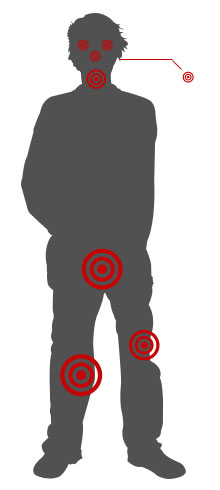
When you’re in a confrontation, you only have a few seconds and a few moves to try before the fight may be decided. Before an attacker has gained full control of you, you must do everything you can –conserving as much energy as possible — to inflict injury so you can get away. (This is no time to be civil. In a physical confrontation that calls for self-defence, it’s hurt or be hurt.) So aim for the parts of the body where you can do the most damage easily: the eyes, nose, ears, neck, groin, knee and legs.
Su Ericksen, who has published multiple articles on self-defense for women, offers techniques for striking these pressure points so you can defend yourself and get to safety. She writes:
Depending on the position of the attacker and how close he is will determine where you will strike and with what part of your body you will employ. Do not step in closer, say, to strike his nose with your hand, when you can reach his knee with a kick.
When striking a target on the upper half of the body you will use your hand. Effective strikes can be made with the outer edge of your hand in a knife hand position, a palm strike or knuckle blow for softer targets or a tightly curled fist.
Here are some photos Su offers on attacking these highly sensitive pressure points:
Eyes:
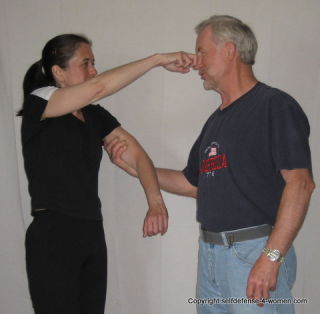
Gouging, poking or scratching the attacker’s eyes with your fingers or knuckles would be effective, as you can imagine. Besides causing a lot of pain, this should also make your escape easier by at least temporarily interfering with his vision.
Nose:

If the attacker is close in front of you, use the heel of your palm to strike up under his nose; throw the whole weight of your body into the move to cause the most pain and force him to loosen his grip on you. If he’s behind you, you can strike his nose (from the side or front) with your elbow. Either way, aim for the nasal bones.
Neck:
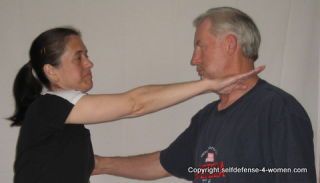
The side of the neck is a bigger target, where both the carotid artery and jugular vein are located. You could possibly temporarily stun your attacker with a knife hand strike (all fingers held straight and tightly together, with thumb tucked and slightly bent at the knuckle) at the side of the neck. For even more injury, you could thrust your elbow into your assailant’s throat while pitching the weight of your body forward. See the Target Focus Training video below.
Knee:
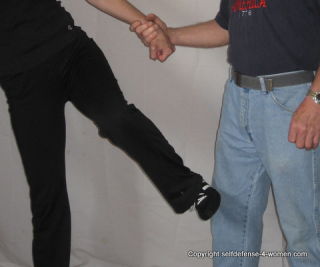
Su says the knee is an ideal self-defence target, vulnerable from every angle and easily kicked without risk of your foot being grabbed. Kick the side of the knee to cause injury or partially incapacitate your attacker. Kicking the front of the knee may cause more injury but is less likely to result in imbalance.
How to Maximise Damage
Use your elbows, knees and head: Those are the parts of the body that are most sensitive when hit. Now here are the parts of the body used most effectively for inflicting damage: your elbows, knees and head (they’re your body’s boney built-in weapons). This video from Elite Defense Systems explains how to defend yourself against three most common attacks by using these key body parts.
Use everyday objects: Everyday objects you carry around with you or things in your environment can also be used to your advantage as weapons. Hold a key or pen between your middle and ring finger while you’re walking home in the dark for more assurance. Outdoors, you can toss some dirt or sand into your attacker’s eyes. Women are often told to spray perfume or hairspray into an assailant’s eyes. The point is, use what ever you can to make your defence stronger (for more inspiration, watch some Jackie Chan movies).
Leverage your weight: No matter your size, weight or strength in relation to your opponent, you can defend yourself by strategically using your body and the simple law of physics. This is the principle behind martial arts systems like Jujitsu and other self-defence programs where a smaller person is able to defeat a larger one.
Tim Larkin teaches in his Target Focus Training self-defence system that striking is not about punching or kicking, it’s about throwing your body weight strategically at someone. You don’t want to be standing there trading punches or kicks with an attacker; in a violent situation, it’s critical to injure him using efficient, targeted moves. Basically, target those pressure points mentioned above, but leverage your weight to cause the most damage. (Note: The video above is a bit long, though all of it is insightful; if you want to skip to the demonstration part showing how to use your body weight in this “point of injury” technique, skip to about the four-minute mark. Also note that this technique, used by law enforcement agencies, can seriously injure the attacker.)
Moves for Getting Out of or Defending Against Common Holds or Attacks
Wrist Hold: When an attacker has grabbed your wrist, instead of pulling back to try to get out of the hold, squat down into a strong stance, then lean forward and bend your elbow towards him all the way towards his forearm until he can no longer hold onto your wrist. You can also try bending your elbow in to get out of the wrist hold, then pushing upwards to break free.
Front and Back Choke Holds: If you’re in a choke hold, swing one arm across to break the attacker’s hold then use your other arm’s elbow or hand in a knife strike position to hit the attacker.
Bear Hug: When someone holds you from behind, drop your weight and try to hit his head with your elbows or stomp his feet with your own. If that doesn’t work, pull his fingers back to force him to release you, rotate out of his hold, and attack him with your knees/kicks. (Pulling fingers is also an effective move in a choke hold in some cases.)
Mount Position: If the attacker has you pinned on the floor, you can pivot to be on top. Hook onto his wrist with one hand and use your other hand to grab behind his elbow, trapping his arm to your chest. Then use your foot to trap his foot and leg, lift your hips and turn over onto your knees to get on top.
Sexual Assault: In my interview with Rener Gracie, whose grandfather established the Gracie Jiu-Jitsu method 90 years ago, he told me there are four phases to nearly all sexual attacks on women: 1) Identify an unsuspecting target, 2) Subdue the target, 3) Exhaust the target, and 4) Execute the sexual assault.
We want to fight with all our might during the second phase using the moves mentioned above. In the third phase, however, right before an assailant executes his sexual attack, all he wants to do is exhaust the victim and gain complete control, so fighting back actually may backfire at that point, wasting energy. Gracie’s Women Empowered training program teaches women to recognise when they’ve entered that phase where they are truly trapped and are no longer in the defensive movements phase — and to feign giving in. Pretend to be compliant (kind of like playing dead for a bear). In those split moments, the predator will think you have given up and will loosen his grip, giving you a chance to injure him and get away.
Resources
These are just a sampling of the kinds of self-defence moves and techniques that might protect you one day or at least help you feel safer and more confident. There’s no replacement, however, for taking a self-defence class and practicing the moves in real life.
To find a good self-defence program, the National Coalition Against Sexual Assault offers these Guidelines for Choosing a Self-Defence Course.
You’ll probably easily find self-defence classes at martial arts centres, but other resources to look into include:
- Local universities or community colleges
- Women’s centres
- Just Yell Fire — a free self-defence movie specifically for girls age 11-19
- C.O.B.R.A. Self-Defence classes — real world self-defence training
- Gracie Jiu-Jitsu Academy — online self-defence training
If you know of any other good self-defence tips, techniques or resources, please share them with us in the comments.
This article has been modified and updated.
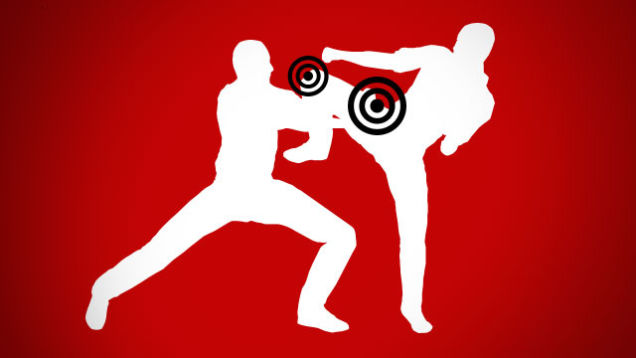
Comments
20 responses to “Basic Self-Defence Moves Everyone Should Know”
Great article. I agree that prevention is the best tactic to have, and that there is nothing wrong with a swift kick to the balls if it means your life.
From my experiences, living in a small town with six nightclubs, assaults in these areas are almost always from drunk people. These people have no common sense and will attack you over petty things with little to no warning.
Your best bet is to either buy them a drink (no, really. Got me out of a few ‘half imagined’ fight scenarios. $8 is nothing compared to medical bills), walk away (Drunk people can’t run that fast) or disorient them by pushing them down and running.
Bookmarked so I can go home and watch all the videos.
Even asking someone’s name, offering yours, and a handshake can turn the mood dramatically. They’re deeply-ingrained rituals, social conditioning that’s very hard to revert away from back to aggression. Someone determined enough can totally do it, but you’d be surprised how easily people can be distracted by those niceties.
I registered to ‘like’ this comment. Waiting for activation email. Meth changed this relatively but yes, psyc student? Agreed.
Practice.
This sounds funny, but after more then 15 years martial arts experience, paractice is everything.
It’s nice to know a few “techniques”, but if you’re not in the right mind set to use them, then they aren’t going to help you. You need to get to the point where it becomes automatic. That is, you just do it without thinking about it.
I’ve met to many people who have done a few weeks of self-defence class several years ago who are carrying to much confidence, but when it comes down to an actual situation, most won’t remember what they are suppose to do.
Also, don’t do just one thing. Hit them in the eye/nose, while you kick them in the groin or knee, have a couple of goes, if something isn’t working, use something else, become difficult to handle and move into a public place as soon as possible.
Don’t kid your self. If a person has placed a hand on you, they most likely don’t mean you good.
ps – After 15 years, I’ve learnt that I can run faster then most people 😉
There are no awards for dead heros.
+1 for this. Of course, it’s hard to get practice unless you walk through dark alleys looking for trouble, as controlled environment training is far different from “heat of the moment” training. Still, a punching bag makes for some good confidence and physical training.
Also, you’re spot on – there are no awards for dead heroes. Do what you need to disable the attacker then run. Pushing them down and kicking them in the side may be enough to get you to a major road to flag down traffic.
Agreed I’ve been training bjj and kickboxing for 15 years the best thing is practice sparing constantly helps your game so much take hard shots to the body you adjust and learn
Exactly this. I’m a krav maga instructor, and you NEED to practice this stuff. What ever martial art or self defense you chose, you need to get out there and actually try it. Reading or watching videos WON’T DO A DAMN THING. ESPECIALLY if you get cracked.
Many years ago, I had some self-defence training from a very, very scary guy. He was short (i.e. too often a target) but solid, with a bald head (with scars) and very softly spoken.
Although a group of testosterone-poisoned 17-19 year old blokes were loath to hear it, this respect-worthy tough guy ended most of the moves with “and then you can run away”
His point was that what you really wanted was not to get hurt. Sticking around to “finish off” an attacker was pointless and he might either get up or his mates arrive.
If someone attacks you, you have every right to rupture their testicles, dislocate their knee, break their nose or whatever else it takes.
Hurt them. Then run away!
…
ow
A major issue in any situation that requires one to defend themselves is panic. You may be aware of the techniques for a successful self defence, and forget everything in the heat of the moment. A good tip is to practice both the techniques discussed above for self defence, and also techniques for calming down quickly to think clearly in a situation of need.
There is no shame in hitting where it hurts, or running away. In the end, it is only important that you escape with your health. Dignity, morals and honour are all important, but none more important than your health and life, as well as that of your friends. These niceties should be reserved for persons that don’t attack others.
oh, i like the way teaches the defence last year ,l was in trouble with two stupid thieves,wanted to beatme for my phone,and through leaning from u l hit them by the nose and legs ,l was free to go ,thank u butpls teach me more .
… Self defense is all about not being where bad things will happen. Everything in self defense is about avoiding the fight (buying a drink, talking your way out of it, just giving the guy your wallet) or running away.
Ignoring for a moment the one unlucky punch death stories we’ve all seen, all the technique in the world is a poor match for a bigger, stronger opponent with a weapon. In mixed martial arts, you often see big strong whitebelts place well in weight division based tournaments – because size and strength matter. Rugby players at martial arts tournaments often do well – because they usually have more experience being genuinely hit than most martial arts types.
And like most martial arts geeks, I know more than a few black belts who never got a chance to try any of their fancy moves, because they took a tire iron to the face before they knew the fight had started, or because somebodies mate had a pick handle in the back of his ute. Hell, I even know of one very brave martial arts instructor who has been wearing a colostomy bag for several years – because he put a mugger in a wrist lock, and the mugger had a knife in his other hand.
Conflict avoidance, and conflict escape are by far the most important skills for any civillian. Cops, the military and security professions/bouncers might have a reasonable agenda to learn how to kick someone’s ass – but for anyone who’s job isn’t to risk their ass in conflict situations – unless you’ve already got ‘running’ and ‘talking down angry people’ – learning where to hit someone is a poor place to start.
Problem with most self defense courses is that they are strength based. However using strength to fight against superior strength is not a match. Go to http://www.selfdefensethesmartway.com and check out how a simple mind switch can put you in a position where winning against a bigger attacker is a foregone conclusion.
I’ll second the effectiveness of Krav Maga which involves practicing getting out of the chokes while having someone actually choke you. I successfully fought off 2 guys with guns trying to rob me a few years ago and retained enough information about them and their vehicle to result in an arrest in less than thirty minutes five miles away. When it was over, I was amazed at how the stuff I had been practicing in Krav Maga sessions for the past few years just kicked in automatically after they told me they were going to shoot me because I didn’t have any money in my wallet. I was able to defend myself, i was able to find an opportunity to run and I kept my wallet and cell phone and the bad guys got caught.
Really? Two guys with guns? That is a lovely story.
You forgot the punchline though..
“And when I woke up, my pillow was gone”.
“There is no such thing as fighting dirty – if it keeps you alive, its fair”
Best quote I ever heard about this subject – and its true. When you’re in fight or flight mode, you’re just gonna try whatever possible to get out of the hold/lock/situation.
Ok so I’ve spent the past 15 years of my life training bjj,kickboxing and boxing I’ve fought my fair share of amateur cage matches and I’ve done quite well so I feel I’m qualified to say something here.
Regarding someone threatening you with a knife in no way should you provoke them by using any form of attack if I’m held at knife point you can take my wallet it’s replaceable.
Regarding wrist locks the best escape technique in my opinion would be rolling forward dive and roll you’ll end up rolling back onto your feet and create a space between the attacker and yourself he will most likely let go you can then run if your fast enough if not your going to have to strike.
Regarding the attacker in Mount if this is a sexual attack then he won’t be in Mount he will be in your gaurd (between your legs) so the reversal suggested by the article simply won’t work there’s a number of other reversals that will unfortunately they are way more technical.
Also you won’t learn anything from watching videos you need to get to a proper fight gym and you need to spar and train before you will be able to identify basic positions and then you probably won’t execute them for at least a year.
Learning how to defend yourself won’t happen overnight it takes hard work dedication and multiple weekly sessions.
Don’t try and be a hero either just because you know the basics doesn’t mean your attacker is just some drunk never underestimate them.
Don’t be afraid to fight dirty if your life depends on it.
…and what happens when an attacker, trained in these same self-defence skills, decides to use them against you in THEIR attack?
The other benefit to pushing someone away and yelling, “Back off!” is that it indicates pretty clearly that you weren’t looking for a fight and wanted an out, in a way that attracts the attention of witnesses. Very helpful in dealing with the legal fallout.
I’ve induced people to release me several times by screaming for the police. The louder you scream, the more people will hear you and potentially help. Conversely, your attacker will be increasingly uncomfortable and tend to look behind them.